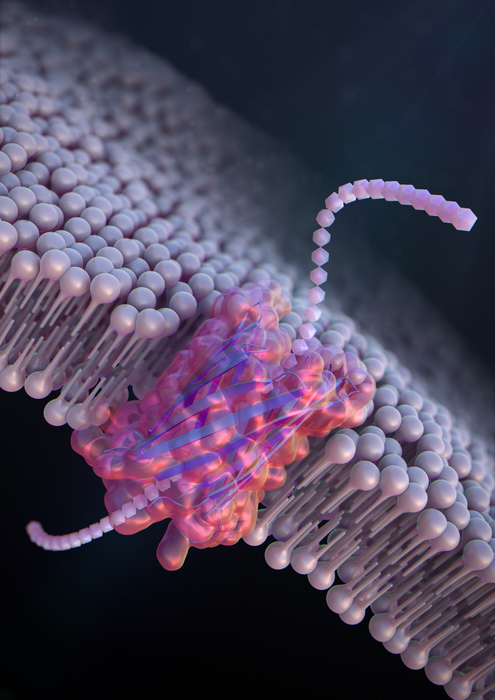Researchers in Japan have designed the first bottom-up designed peptides, comprising chains of amino acids, that can form artificial nanopores to identify and enable single molecule-sorting of genetic material in a lipid membrane.

Credit: Ryuji Kawano, Tokyo University of Agriculture and Technology
Researchers in Japan have designed the first bottom-up designed peptides, comprising chains of amino acids, that can form artificial nanopores to identify and enable single molecule-sorting of genetic material in a lipid membrane.
Biological nanopores are generally channels made by pore-forming proteins, that can detect specific molecules, but such natural channels are difficult to identify, limiting proposed applications in low-cost, speedy DNA sequencing, small molecule detection and more.
“Nanopore sensing is a powerful tool for label-free, single-molecule detection,” said corresponding author Ryuji Kawano, professor in Tokyo University of Agriculture and Technology (TUAT) in Japan. “This is the first time that DNA and polypeptides were sensed using a de novo-designed nanopore.”
They published their findings on November 22 in Nature Nanotechnology.
The de novo-designed nanopores are built “from scratch,” according to Kawano, and have the potential to mimic natural proteins and their ability to detect specific proteins. Crucially, Kawano said, they can also be engineered to act as artificial molecular machines capable of detecting a much wider range of molecules — which may help elucidate the connection between structure and function in target proteins.
“The folded structure of proteins is determined by their linear polypeptide sequence and gives rise to specific protein functionality,” Kawano said, noting that all proteins have a unique structure and size. “The unique primary structure is the result of structural evolution such as the mutation and selection of amino acid residues over time. To reveal the relationship between this primary information and protein structure is one of the ultimate goals of science.”
To develop large synthetic nanopores that can better detect and identify molecules for practical applications, Kawano and the team designed a peptide dubbed SV28. With two arms of amino acids bent at a sharp angle, and specific charges at the terminus, the orientation of the hairpin-shaped peptide can be precisely controlled by applying a voltage. The peptide can assemble to form nanopore structures ranging in size from 1.7 to 6.3 nanometers, suitable for detecting molecules of DNA.
The researchers also modified SV28 by adding a mutation that causes the peptide structure to bend and twist in specific ways. The resulting peptide formed evenly dispersed pores of 1.7 nanometers each, capable of detecting a single polypeptide chain — or one half of a protein.
This achievement could be applied to facilitating the understanding of the relationship between protein structure and function.
For the next steps, the team plans to design various peptides and proteins to construct different types of nanopores to aid in peptide sequencing, operate as molecular robots, and more.
Other contributors include Keisuke Shimizu, Masataka Usami and Ikuro Mizoguchi, Department of Biotechnology and Life Science at Tokyo University of Agriculture and Technology; Batsaikhan Mijiddorj and Izuru Kawamura, Graduate School of Engineering, Yokohama National University; Shuhei Yoshida, Shiori Akayama, Yoshio Hamada and Kenji Usui, Faculty of Frontiers of Innovative Research in Science and Technology, Konan University; and Akifumi Ohyama, Graduate School of Engineering Science, Yokohama National University.
Mijiddorj is also affiliated with the School of Engineering and Applied Sciences, National University of Mongolia. Kawamura is also affiliated with the Graduate School of Engineering Science, Yokohama National University.
The Japan Society for the Promotion of Science (19H05382 and 21H00390), the Ministry of Education, Culture, Sports, Science and Technology (19H00901) and the Mongolian-Japan Engineering Education Development Program partially supported this research.
##
For more information about the Kawano laboratory, please visit http://web.tuat.ac.jp/~rjkawano/en.html
Original publication:
De Novo Design of a Nanopore for Single-Molecule Detection that Incorporates a β-Hairpin Peptide
Keisuke Shimizu, Batsaikhan Mijiddorj, Masataka Usami, Ikuro Mizoguchi, Shuhei Yoshida, Shiori Akayama, Yoshio Hamada, Akifumi Ohyama, Kenji Usui, Izuru Kawamura, and Ryuji Kawano*
*: corresponding author
DOI : 10.1038/s41565-021-01008-w
About Tokyo University of Agriculture and Technology (TUAT):
TUAT is a distinguished university in Japan dedicated to science and technology. TUAT focuses on agriculture and engineering that form the foundation of industry, and promotes education and research fields that incorporate them. Boasting a history of over 140 years since our founding in 1874, TUAT continues to boldly take on new challenges and steadily promote fields. With high ethics, TUAT fulfills social responsibility in the capacity of transmitting science and technology information towards the construction of a sustainable society where both human beings and nature can thrive in a symbiotic relationship. For more information, please visit http://www.tuat.ac.jp/en/.
Contact:
Ryuji Kawano, Dr.
Professor
Department of Biotechnology and Life Science,
Tokyo University of Agriculture and Technology (TUAT)
Journal
Nature Nanotechnology
DOI
10.1038/s41565-021-01008-w
Article Title
De novo design of a nanopore for single-molecule detection that incorporates a β-hairpin peptide
Article Publication Date
22-Nov-2021




